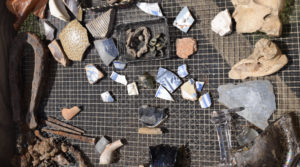
April, 2018 — For early April, archaeologists couldn’t ask for better weather. A gentle breeze, low humidity and comfortably cool shirt-sleeve temperatures were ideal for wielding a trowel and shovel. As I walked with camera in hand along a path through a grassy flat of land that was once graced with early 17th century structures, I spied a small team of archaeologists swarming about a single excavation unit — a shallow hole in the ground, squared off with near-perfect vertical walls defining its perimeter. They were digging up, with carefully managed precision, an old excavation unit completed in part in the 1930’s by a previous excavation team. They were going over old ground, but with new techniques and new objectives, digging deeper into a stratigraphy that began to yield artifacts — including early 17th century objects — not reached and recovered by the old excavation. Towering above them just a few yards away were the imposing ruins of the 18th century plantation mansion of Richard Ambler, one of Jamestown’s prominent and wealthiest citizens. I couldn’t resist snapping a few photos of this old house. It commanded the view of the landscape, drowning out, with its great architectural shout, everything else on the surface within its vicinity. But a far more compelling story was beginning to emerge as these archaeologists dug beneath the grassy yard in which the old ruin stood. It was far less noticeable to the visitor’s eye — but much more intriguing……….
_____________________________________
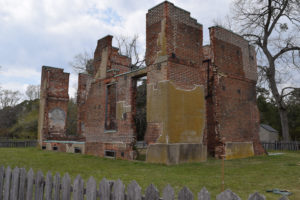
Ruins of the Ambler Mansion, built about 1750.
______________________________________
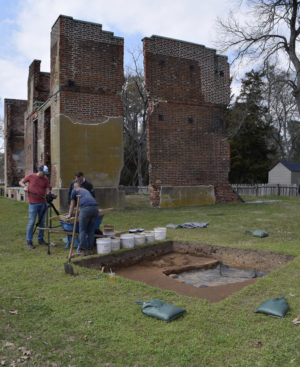
Archaeologists at work on the lone excavation unit near the foot of the Ambler Mansion.
______________________________
The Back Street Boys
Leading the dig project was David Givens, a senior archaeologist with the Jamestown Rediscovery Historic Jamestowne project, under the auspices of the Association for the Preservation of Virginia Antiquities (or APVA/Preservation Virginia). The excavations at Jamestown have been best known in recent decades for the discovery of remains connected to the original 1607 James Fort under William Kelso, which have thus far yielded hundreds of thousands of artifacts and archaeological features that define the very first ‘footprint’ for successful permanent English settlement in the Americas. Excavations at the site of the Fort are ongoing. But beginning in 2017, Givens and his team began excavating an area within easy walking distance east of the original fort location. It contained evidence of occupation known historically as the property of Captain William Pierce*, a wealthy and influential planter and merchant who built an impressive house within the newly developed town east of the James Fort area (known as New Towne) in the wealthy section known as ‘Back Street’. His home was described as “one of the fairest in Virginia”, set in a neighborhood that housed the likes of the city’s most prominent and wealthiest citizens, such as Dr. John Pott, Governor Sir Francis Wyatt and Governor John Harvey. Future years saw the construction of even finer brick homes in this section by society notables like Richard Kemp, William Sherwood, Henry Hartwell and William May. It was here, also, where the before-mentioned planter Richard Ambler built his mansion in the 1750’s, the ruins of which still visibly mark the landscape today.
For its time, Back Street represented some of the finest physical fruits of colonial America’s richly bequeathed and successfully enterprising gentlemen visionaries, planters and merchants. But their high level of 17th century upscale living involved, among other things, the employment of labor through the servitude of others to do the work that the landed gentry would not do to support their privileged lifestyles. In early 17th century America, this meant the importation of human servants. Among them were the first Africans to land on American English colonial soil — the embryo of what would become slavery — and the households along New Towne’s illustrious Back Street were the first to take in African servants. For Givens and his team, the archaeology of the William Pierce property thus presented a unique opportunity to reveal the material and cultural context in which the first Africans, and thus the rudiments of the beginning of slavery, emerged. A mandate supported by initial funding from the National Park Service under a civil rights initiative grant during the Obama Administration made this possible.
_______________________________
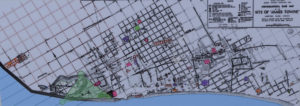
The “Cotter”map showing some of the previous archaeology done in New Towne, the 17th- century town that grew up east of James Fort. The grid system used 100′ blocks with trenching every 50′. Larger open areas were excavated around some sites and buildings. Archaeological excavations were last conducted in New Towne in the 1990’s. Archaeologists today are using the same grid system to tie in their excavations with the previous work. Image and text photographed from a plaque display near the site of excavations at the Pierce property site.
______________________________
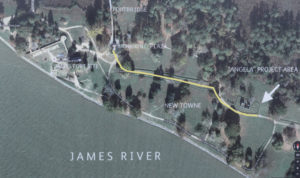
The project area is on the Pierce property in New Towne, located just past the 18th-century Ambler mansion ruins, about 325 yards east of the tercentary obelisk monument. Image and text photographed from an informational plaque near the Pierce property excavation site.
______________________________
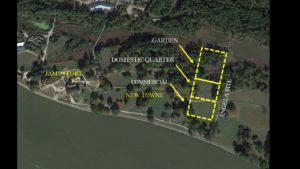
The targeted Pierce property excavation area near the Ambler Mansion. Courtesy David Givens and the Jamestown Rediscovery Historic Jamestown Project, Preservation of Virginia Antiquities
_________________________________
Angela and the Beginnings of Slavery
Written history has not been generous to posterity about revealing the lives of English colonial America’s first Africans. But in early 17th century Jamestown, a 1624 muster (census) indicated the presence of 21 Africans. One of them, a female African servant referred to as ‘Angela”, was connected to the household of Captain William Pierce. Based on other historical documents, Angela is presumed to have been among the first group of Africans to arrive in Jamestown in 1619.
Interestingly enough, the historical context of her journey and arrival in America was actually defined by the intersection of the early 17th century world slave trade and high seas piracy.
Between 1618 and 1619, the Portuguese nobleman and colonial Governor Luis Mendes de Vasconçelos of Angola (in West Central Africa) led a series of campaigns that resulted in the capture of thousands of Kimbundu-speaking people —men, women and children — to populate six slave ships bound for Mexico. Well before the slave trade began to have any impact on the fledgling English colonies in America, the Spanish and Portuguese were funneling new slave power into the developing colonial economies of their realms in the New World — in this case, the rising economy of Vera Cruz in New Spain (present-day Mexico). Little did Vasconcelos know, however, that some of his cargo would ultimately end up at Jamestown, via pirating by the English in 1619. The ship São João Bautista, carrying about 350 enslaved Africans after departure from the port of São Paulo de Loanda, a Portuguese military outpost in West Africa, found itself about 50 slaves lighter after being intercepted by the White Lion and the Treasurer off the coast of Campeche (in present-day Mexico), both ships having sailed out of the Netherlands. The ships arrived at Point Comfort (on the coast of present-day Virginia) in 1619, unloading their human cargo for sale to early English planters who transported them to the newly founded English colony and its surrounding developing plantations. Angela was likely among them.
Were these first Africans, including Angela, actually slaves or something more akin to indentured servants who, after a period of time, were permitted to acquire their freedom and live independent lives? The probability is high that this may have been their status, as slavery as it was codified into law in the colonies decades later did not exist at that time in the form most familiar to American history. But these first Africans nonetheless arguably laid the foundation upon which the institution of slavery was born and flourished through the subsequent decades.
The Excavations
Contrary to what the popular perception might be about the newly opened dig, these excavators are not looking for the human remains of slaves.
“A lot of people think we’re looking for Angela,” said Givens. “But that’s not what we’re doing. We’re looking at the contextual — the world in which Pierce was an actor [and by extension Angela].”
It will be a long and tedious task. “There are 243 years of slavery under your feet,” Givens told me as we stood together next to the excavation unit as the archaeologists worked. “Here, folks came and went in fairly quick succession in the 17th century. And Pierce’s property was extensive, including two storehouses and planting areas.” It was located in a city, so this is “like searching for a needle in a stack of needles.” Givens showed me a selected sampling of artifacts unearthed from the unit. This assemblage included fragments of ceramic ware produced by a Jamestown potter during the 1st quarter of the 17th century. They were taken from three bulging paper bags of objects excavated only within the last week and a half from the single unit.
Givens leads me to a much larger excavated area only steps away from the smaller unit. He points out some exposed features at the location of the early 17th century Pierce residency. We were looking at what he described as possibly a “half cellar” space, tentatively and roughly dated, based on the finds within the cellar and its context, to no later than the 1630’s. Excavations have continued since my visit to the site. Since then, says Givens, “we are now finding artifacts that date prior to 1625. We are very near a component of the Pierce holdings”.
______________________________
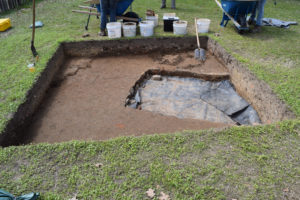
A view of the excavation unit near the Ambler Mansion as it appeared in early April, 2018.
_______________________________
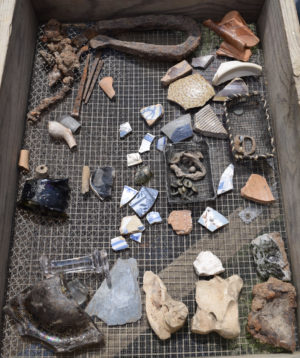
A small sampling of the assortment of artifacts unearthed from the excavation unit during a single week and a half of work at the site.
__________________________________
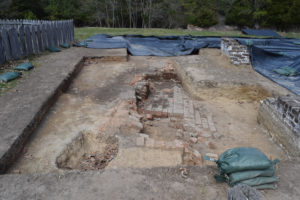
A view of the main excavation site at the location of the Pierce property as it appeared in early April, 2018.
________________________________
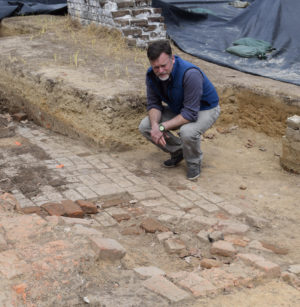
David Givens examines some recently excavated features at the site.
______________________________
This excavation is only in its beginning stages. There is a long way to go. The project could require, in Givens’ estimation, at least 10 years, “if not a career” to bring everything to a conclusion. More funding will be sought. The biggest takeaway will revolve around helping to elucidate the world in which Angela and her other First African contemporaries lived, and, if the archaeologists and historians are so fortunate, even add to our knowledge of specifically how Angela lived, what she ate, how she may have been treated, and what she may have seen or witnessed about early 17th century Jamestown.
“We will find the empirical evidence and test it against the historical record — a record that was produced primarily by rich, white, educated males,” said Givens. But, he added, “I think the archaeology and history is showing (at this early stage) how diverse the emerging colonial landscape was. Our modern notions of race and how folks negotiated their lives has been generalized (and perhaps white-washed) over the centuries. At Jamestown, archaeology can play a key role in reorienting our understanding of how First Africans impacted the material record of a very complex world of colonial entanglement. By unpacking this history, we are addressing the integral role individuals, like Angela, played in the growth of our Nation and how we view that past.”
Popular Archaeology will be covering new developments in the future as they emerge from the excavations.
Stay tuned.
_______________________________
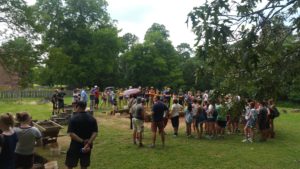
Members of the public visiting the excavation site. One of the reasons for selecting the site for excavation was because of its visibility and accessibility to the public. Courtesy David Givens and the Jamestown Rediscovery Historic Jamestown Project, Preservation of Virginia Antiquities
_______________________________
Read more about the exciting archaeological work and latest discoveries on Virginia’s Jamestown Island by visiting this site.
Did you like this article? See George Washington’s Forgotten Slaves, published in a previous issue.
__________________
*”A wealthy, influential planter and merchant who had arrived in Virginia in 1610, Peirce also owned a store in Jamestown. A “beloved friend” of Governor Francis Wyatt, Captain Peirce was the colony’s cape merchant and also served as lieutenant governor and commander of Jamestown Island. He was responsible for the island’s two blockhouses and appointed captain of the governor’s guard.” https://www.findagrave.com/memorial/103843198/william-pierce
__________________





